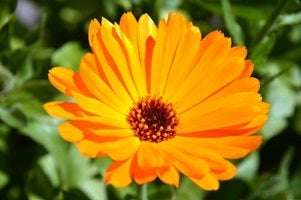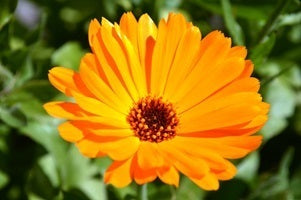Marigold Pot
Marigold Pot
Packet Size: 50 seeds
Couldn't load pickup availability
The cheerful blooms of Pot Marigold (Calendula officianalis) follow the sun, opening with the morning light and closing as it fades – like little solar clocks in your garden. A classic annual growing to around 30–45 cm tall, calendula is a reliable all-rounder for any garden.
It's a hardworking companion plant too, attracting the kinds of insects that feast on aphids and other garden pests.
With vivid orange and yellow petals, calendula adds a burst of colour to your veggie beds and makes long-lasting cut flowers to brighten up your home The petals are edible and can even be used as a natural food colouring or dye.
Eye-catching, pollinator-friendly, and easy to grow—calendula is a garden favourite for good reason.
Grow it for beauty, for the bugs, or just because it makes you smile!
This variety is part of our naturally nurtured range, the seed comes from an organic source
SPRING
- Sow seeds in a tray with a very light covering.
- Pot up into individual pots when large enough to handle
- Grow on ready to plant out.
SUMMER
- Plant out into the garden
- Dead head regularly to keep those flowers coming.
- Harvest fresh petals for culinary use (great for colouring for rice).
- Collect flower heads and tops for natural dyeing
AUTUMN
- Pull up and compost old plants.
- Add to the compost heap to return goodness to the soil
📌USES:
GREAT FOR WILDLIFE
- Loved by Honey Bees and Bumblebees, who flock to its nectar-rich blooms.
- Hoverflies visit for pollen—and their larvae help control aphids and other soft pests.
- Sow around veg beds to attract Lacewings, whose larvae are ferocious aphid-munchers.
- Butterflies and moths regularly stop by, especially in warm weather.
- You’ll often find Ladybirds nearby too, helping with pest control.
- RHS-listed as a top plant for pollinators.
EDIBLE
- The flowers are edible – add to salads, decorate cakes or use as a saffron substitute
- Fresh petals are a traditional yellow cheese colorant
- Use to colour rice yellow
- The leaves have a slight bitterness but young leaves can be added to spring salads.
IN THE GARDEN
- Plant near where you might eat in the garden – reputed to keep flies and mosquitoes away – or crush the leaves and scatter
- The sticky substance on the pot marigold leaf attract and trap aphids
- A good addition to your compost heap - it has been suggested it quickens the breakdown of compost
- For those with a greenhouse or coldframe these are particularly useful to attract pollinating insects into those spaces plus they help deter whitefly.
- They simply are a very cheerful flower to grow and enjoy.
NATURAL DYE PLANT
- Colours ranging from butter, gold & yellow to orange. When modified with alum & iron, you can expect shades of olive-green
- You can use the flowers & plant tops
- Flowers can be gathered and frozen until you have enough to ‘play’ with
- Using Calendula officianalis to dye with: scroll down for this information
HISTORICAL
- Calendular officianalis is one of the oldest of all cultivated flowers - described in 300 BC
- It has been used for medicinal purposes since at least the 12th century
- The flowers are known to close when rain is expected and so they have culturally been used as a rough predictor for weather
- A symbol of redemption after death in Christian mythology
- In Mexico it is also considered a flower of death, believed to originate from the blood of the indigene people slain by the Spanish conquerors
- Calendula has numerous mythological properties, such as the ability to strip a witch of her will, or wreaths of marigolds hung over a door would prevent evil from entering. They were specifically picked at Midsummer for their supposed healing properties
MEDICINAL: see caution
- The flowers (or an extract of calendula) are valued for their medicinal properties, for healing and soothing in particular
- Modern pharmacological studies have shown fungicidal, anti-viral and anti-inflammatory properties in calendula extracts: there are claims about treatment for acne and dermatitis, however studies are inconclusive on its effectiveness
- Caution: anybody wishing to use plants for medicinal effect are advised to consult their medical professional
- Please Note: we do not promote the medicinal use of plants – guidance and information should be sought elsewhere.
DID YOU KNOW
- The seed shaped like a letter C it is actually an achene, which is a fruit that contains the seed
DYEING WITH CALENDULA OFFICIANALIS
- Prepare your T-shirts or fabric: Scour/wash, Mordant & Rinse or Bind (find out more here)
- You will need a stainless steel sieve
Prepare the Pot Marigold Dye bath
- Fresh, dried or frozen Pot Marigold flowers. I like fresh or frozen flowers but you need more than if using dried. At a minimum 100% dried flower weight to dry fabric weight and if using fresh flowers then you need about double the weight of flowers to fabric weight. Use a bit more when using frozen flowers, no need to defrost, remember dyeing is not an exact science.
- The dye bath is a bit like brewing tea for a long time – half fill your dye pot with water (you need a large enough pot and dye water to give space for the fabric for the stage after this), bring to the boil before adding your Pot Marigold flowers, boil them for about 5 minutes before reducing the temperature and simmering for an hour. If possible leave them soaking overnight.
- Sieve out the flowers (they can be added to your compost heap) and return the dye water to the pot before adding your pre-soaked T-shirt, submerge it and pop the lid on.
- Gradually bring back to a simmer, gently stirring your fabric occasionally for an even coverage and you are happy with the colour. Turn off the heat and let the dye pot cool sufficiently that you can wring out your T-shirt… you can leave the fabric soaking overnight for the colour to deepen. Adding vinegar or lemon juice can brighten the yellow (these are be dye modifiers).
- The dyebath can be used for another T-shirt (it will be a paler shade as some of the dye has been used) or tipped out into your garden.
- Rinse your T-shirt then gently hand wash with Ph neutral detergent and rinse again (it is normal for some dye to wash out), hang in the shade to dry. Once the fabric is dry you can further ‘set’ the colour by ironing with a hot dry iron. Wear and enjoy your Callendula officinalis dyed T-shirt.

Collapsible content
Sowing
- Mar
- Apr
- May
Harvesting / Flowering
- Jun
- Jul
- Aug
- Sep
- Oct

